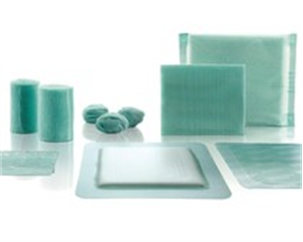Code: 7216100
PIP Code: N.A.
Pack Qty: 40
Cutimed® Sorbact®

DACC-coated antimicrobial dressings
Unlike dressings which depend on antimicrobials or antiseptics to remove bacteria from contaminated and infected wounds, Cutimed Sorbact is the first range of wound dressings to work without a chemically active agent.
By the physical principle of hydrophobic interaction, within 30 seconds1, bacteria and fungi become physically and irreversibly bound to the dressings' specially coated surface of DACC. Therefore with every dressing change, the bound bacteria and fungi are simply removed from the wound bed2.
The use of Cutimed Sorbact dressings are also not linked to contraindications and side effects that are associated with the use of other antimicrobial dressings.
How it works
Hydrophobic interaction is a basic physical principle. Hydrophobic substances and organisms attract and bind to each other in an aqueous environment and are held together by the forces of the surrounding water molecules.
Cutimed Sorbact dressings are coated with DACC, a hydrophobic fatty acid derivative which gives the dressings their highly hydrophobic properties. In the moist environment of an infected wound, bacteria are attracted to the dressing and become irreversibly bound to it. Pathogenic wound bacteria and fungi also display hydrophobic properties so will readily attach to the dressings3
Cutimed Sorbact is available in a wide range of shapes, sizes and absorbency. They can be used safely5 on all types of colonised or infected wounds regardless of their aetiology:
- Chronic wounds such as venous, pressure or diabetic foot ulcers
- Post-operative or dehisced surgical wounds
- Traumatic wounds
- Wounds after excision of abscesses
The dressing can also be used prophylactically to prevent recurrence, providing moisture is present.
References
1) Ljungh A., Yanagisawa N., Wadström T.: Using the principle of hydrophobic interaction to bind and remove wound bacteria. JWC (2006) 15/4: 175-180. 2) Kammerlander G. et al: Non-medicated wound dressing as an antimicrobial alternative in wound management. Die Schwester Der Pfleger (2007) 46: 84-87. 3) Ljungh Å., Wadström T.: Growth conditions influence expression of cell surface hydrophobicity of Staphylococci and other wound infection pathogens. Microbiological Immunology (1995) 39/10: 753-757. 4) Robertson E.: Treatment of Candida infection with a fungus adsorbing dressing. Sår (2007) 1: 26. 5) Haycocks S. et al: Use of a DACC-coated antimicrobial dressing in people with diabetes and a history of foot ulceration. Wounds UK (2011) 7: 11, 108-114




